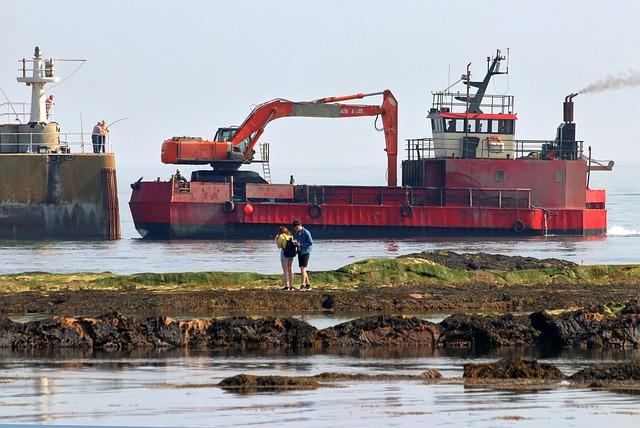Finding the Right Dredging Solution: Key Tips to Follow
Dredging is a crucial operation for maintaining the depth and navigability of waterways, ports, and lakes. It involves removing sediment and debris from the bottom of bodies of water to keep channels open, maintain water quality, and protect coastal areas. Selecting the right dredging equipment and tools can make the process more effective and reduce the environmental impact. Here are some essential tips for finding the best dredging solutions for your specific project needs.
Consider Equipment That Supports Your Needs: Hose Floats
Managing dredging hoses is essential to ensuring efficiency and safety in dredging operations. Hose floats are specifically made for dredging applications and play a vital role in keeping hoses above water. By preventing hoses from sinking, hose floats reduce the chances of tangling, reduce wear and tear, and minimize equipment damage, all of which enhance safety and overall project productivity. Selecting compatible hose floats for the diameter, weight, and type of your hoses can improve the efficiency of dredging, allowing for uninterrupted work. Proper hose management through quality floats is essential to maintaining a safe and efficient dredging environment and can save time and costs over the life of the project.
Assess Your Project’s Scale and Depth Requirements
Dredging solutions must be tailored to fit the unique needs of each project, particularly concerning the scale and depth of the work area. Small-scale dredging may involve shallow recreational water bodies or smaller channels, while large-scale operations—such as maintaining commercial ports—require more robust equipment capable of handling significant depth and sediment volumes. Before making an equipment choice, it's important to evaluate the specific scale and depth requirements of your project. For deeper projects, dredges with extended reach and enhanced suction power are essential, allowing for precise sediment removal at great depths. Accurately assessing these factors can help you choose equipment suited to your project, reducing disruptions and enabling efficient sediment removal from start to finish.
Select the Right Type of Dredge for the Job
Not all dredges are created equal, and different dredge types are designed to handle various materials and environments. Cutter suction dredges are ideal for working through compacted sediment, as their rotating cutters can break down solid material before suctioning it. Trailing suction hopper dredges, on the other hand, are suitable for looser, sandier materials and are often used in ports and open-sea dredging projects. Additionally, grab or clamshell dredges are effective in confined areas and ideal for precise dredging projects. Knowing your project's sediment type and environment will help you select a dredge that performs efficiently, saving both time and energy. Each type offers unique benefits and should be matched carefully to the specific conditions of your project to avoid complications and enhance productivity.
Prioritize Environmental Considerations in Your Equipment Selection
The environmental impact of dredging operations can be significant if not carefully managed. The equipment and methods chosen play an important role in minimizing ecosystem disruption. Environmentally conscious dredging equipment and methods reduce sediment resuspension and limit the release of pollutants into the water. Look for technology that allows precise dredging, with minimal sediment disturbance, as well as features designed to capture and safely remove contaminants. Targeted dredging equipment, for instance, is engineered to address specific areas without disturbing adjacent habitats. By prioritizing equipment that adheres to environmental standards, you protect aquatic ecosystems and help your project comply with regulations, avoiding potential fines or delays.
Consider Maintenance and Long-Term Costs of Your Equipment
While initial equipment costs are a primary consideration, it’s essential to factor in long-term maintenance expenses. High-quality dredging equipment with a reputation for durability and reliability will often save on repair and replacement costs in the long run. Consider the availability of replacement parts and ease of maintenance when choosing a dredge, as these factors contribute to the overall cost-effectiveness of your project. Regular maintenance extends the life of your equipment, reduces downtime, and ensures efficient operation, ultimately helping you to stay within budget. Additionally, some dredging equipment manufacturers offer maintenance packages or warranties that can reduce future repair costs, making them a valuable investment.
Consult with Experts to Tailor Solutions to Your Project
Dredging projects come with unique sets of challenges, and consulting with industry experts can help ensure you select the right equipment and strategies. Experienced professionals provide valuable insights, from recommending the best hose floats for your project to guiding you in choosing a dredge type suited to your location and sediment type. Experts also help in navigating local regulations, environmental standards, and best practices to ensure compliance and effective project execution. Collaborating with dredging specialists can streamline your project, address potential obstacles before they arise, and provide peace of mind that the equipment choices will lead to a successful operation.
Budget for Additional Equipment and Project Support
Beyond the primary dredging equipment, additional tools and support systems can contribute to an efficient operation. Items such as GPS mapping, water-quality monitoring tools, and silt curtains are often overlooked but can be instrumental in optimizing the dredging process. GPS mapping, for instance, allows you to track progress and ensure dredging takes place precisely where needed. Silt curtains help control sediment spread, minimizing environmental impact. These additional pieces of equipment not only improve project outcomes but also help meet regulatory requirements. Budgeting for supplementary tools in your dredging plan can make the difference between a basic and a highly efficient dredging operation.
Choosing the right dredging equipment and support systems is essential for a successful project. By considering factors such as hose floats, project scale, dredge type, and environmental impact, you can ensure that the operation runs smoothly, safely, and efficiently. Working with industry experts and investing in high-quality, reliable equipment can also help you achieve desired results and maintain compliance with environmental standards. With the right dredging solutions, your project will not only meet its goals but will also minimize its footprint, ensuring long-term sustainability and success.

